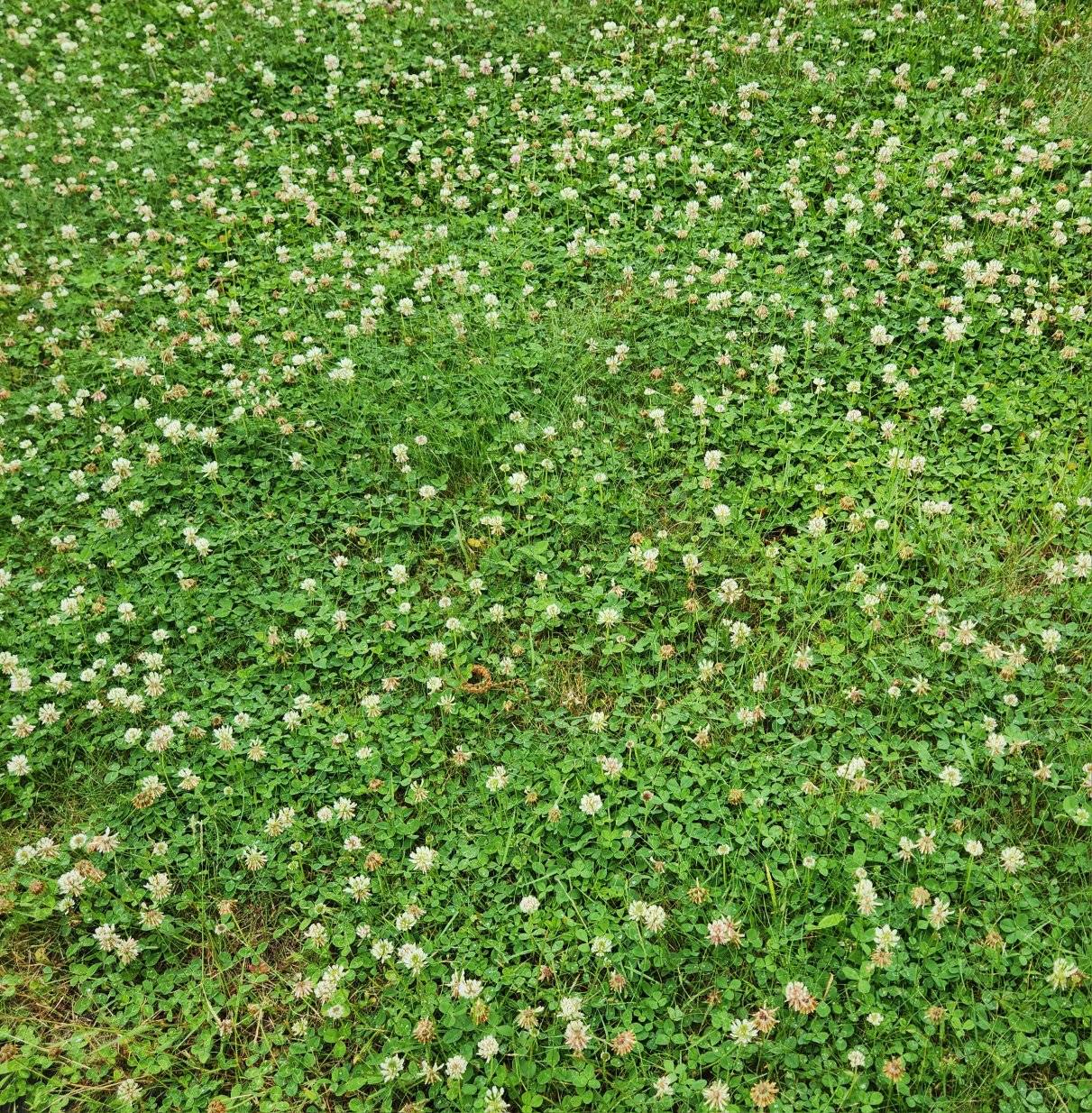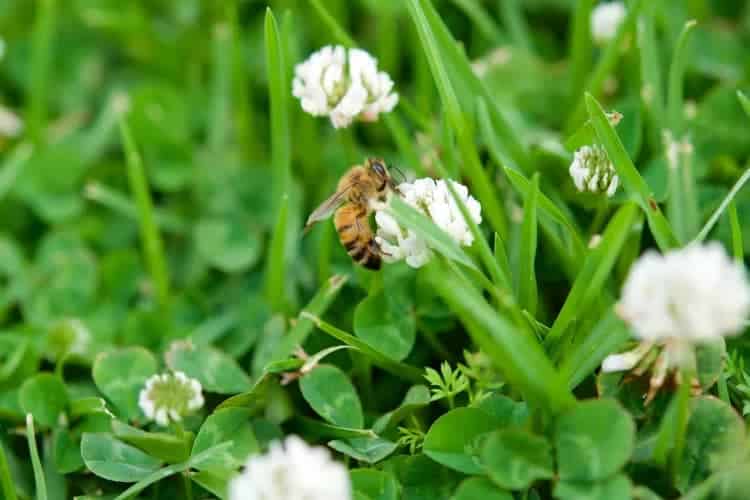I love the soft, cushiony feeling of stepping on clover, but my sentiments on this flowering plant aside, not everyone likes it. Clover in lawn can be a nuisance, especially if you want to keep a uniform grass lawn.
So, if this weed invades your lawn, you’ll naturally want to figure out how to get rid of clover in lawn.
Clover is pretty invasive, so left to flourish, it will quickly take over your lawn, suppressing your grass. Fortunately, although challenging, you can successfully kick it out of your yard using proven methods.
This guide will help you get rid of clover from your lawn.
What Causes Clover In Lawn?
Are you wondering why clovers have invaded your lawn? Below are the conditions that make your lawn conducive for clover growth and flourishing.
1. Soil Conditions
Clover love and thrives in soil with low nitrogen content. Therefore, this nitrogen-fixing plant will establish itself on your lawn if it has poor soil fertility or lacks nitrogen, thus outcompeting grass and establishing itself.
This self-sufficient plant also thrives in neutral to slightly acidic soil conditions and could be why you have them growing on your lawn. Furthermore, the absence of other essential nutrients like potassium renders your lawn perfect for clover growth.
Also Read:
2. Mowing Height
Do you mow your lawn too low? If that’s the case, you are creating space for clover to grow by weakening the grass, keeping it from successfully competing with clover. Also, low mowing heights can remove the top growth of clover plants, stimulating lateral growth and allowing it to spread more rapidly.
So, help your grass develop a stronger grass canopy that competes with clover and shades the soil by setting your mower blade to a higher height, usually around 2.5 to 3.5 inches (6-9 cm).
3. Moisture Levels
Excessive moisture or poor drainage in lawn encourages the growth of clover. Therefore, don’t be surprised if you find clover in parts of your lawn that stay consistently damp or receive excessive irrigation.
4. Poor Lawn Health
Your lawn is more susceptible to clover invasion if weakened or damaged by disease, insect infestations, or neglect. On the contrary, keeping a healthy, dense lawn helps suppress clover growth by competing for resources and limiting available space.
5. Soil Compaction
You are typically encouraged to aerate your lawn to keep the soil from being compact. Compact soil restricts grass growth and reduces the ability of grass to compete with weeds like clover.
6. Seed Source
Wind, animals, or contaminated soil can carry clover seeds to your lawn from neighboring areas. You might also be the reason clovers are in your lawn by introducing the seeds unintentionally.
How To Get Rid Of Clover In Lawn
Get rid of clover from your lawn using these methods. While all of them are effective, pick the one that suits you, considering your preferences and the extent of the invasion.
1) Hand-pulling
Specialized tools or chemicals aren’t necessary, especially when dealing with a limited number of clover plants scattered throughout your lawn. Your hands will get the job done; just put on gardening gloves, get close to the ground, grasp the clover plant’s base near the soil surface, and gently pull upward.
Ensure you take out the whole root system to curb regrowth. While this approach may seem cumbersome, taking time and effort, truthfully, this only applies when dealing with an extensive infestation. However, it is highly effective for small-scale control.
2) Weed Tool Or Dandelion Digger
Are you dealing with a few clovers but with well-established root systems? Put your weed tool or dandelion digger to use. Insert the tool into the lawn soil adjacent to the clover plant, angling it to get beneath the roots. After that, apply pressure to lever the plant out of the ground, extracting the whole root system.
Be thorough to prevent regrowth.
3) Herbicides
Would you rather avoid manual methods, or are they ineffective in your situation because your lawn has too many clovers? Consider using selective herbicides formulated to target broadleaf weeds like clover.
Ensure you choose herbicides labeled for lawn use and safe for your grass species.
Also, knowing that herbicides can harm desirable plants if not used correctly, proceed cautiously and follow the instructions. You are better off spot-treating affected areas than applying herbicides to the entire lawn.
4. Smother Clover
Reserve this approach for dealing with large clover patches because you risk killing grass if you use it on small or irregular clover patches. Smothering deprives plants, including clovers, sunlight, and air which are resources they cannot survive without.
Place the cloth or tarp over the affected area for several weeks, ensuring it is securely anchored (secure the edges with large rocks or bricks). Lack of sunlight will weaken and eventually kill the clover. Monitor the area regularly to check for progress and remove any remaining clover.
5. Apply Vinegar Mix
Do you prefer natural herbicides to commercial ones? Spray a mixture of distilled white vinegar and water directly into the clover leaves to disrupt the plant’s cellular structure, thus making them wither and die.
If you choose this method, multiple applications may be necessary because vinegar mix is less potent than commercial herbicides.
How To Prevent Clover In Lawn
So, you have successfully eliminated clover from your lawn and are feeling pretty amazing, as you should. However, your work isn’t over. You must ensure these resilient weeds don’t grow back in the future. But how do you achieve that? Do the following.
i) Improve Lawn Health
Give your lawn the best chance of suppressing clover growth by ensuring it stays healthy and dense. The grass in your lawn will be healthy and strong if you implement proper lawn care practices.
These include regular mowing at a higher height, adequate watering (avoiding overwatering), and appropriate fertilization.
ii) Improve Soil Conditions
On the one hand, clover favors acidic soil, while on the other, grasses typically flourish in slightly alkaline soil with a pH of around 6.5 to 7.0. So, perform a soil test. The soil test will shed light on the nutrient deficiencies and imbalances you must address.
For instance, if you discover that the soil pH is off, adjust it to maintain optimal levels for your grass species. For too-acidic soil, apply lime to raise the pH by neutralizing acidity and creating a more favorable environment for grass growth.
iii) Apply Nitrogen-Rich Fertilizer
Since clover prefers low nitrogen levels, why not make your lawn hostile for them by applying nitrogen-rich fertilizer to the patches of clover? The increased nitrogen levels in the soil can help the grass grow thicker and healthier, allowing it to better compete with and suppress clover growth.
Apply the nitrogen-rich fertilizer during the active growing season of your grass, typically in spring and fall. If the clover infestation is concentrated in specific areas of your lawn, consider spot-treating those areas with a liquid herbicide that targets broadleaf weeds.
While a fast-release fertilizer is affordable and convenient, you can go the organic route by using liquid kelp, cow manure, earthworm castings, bone meal, guano, and blood meal.
iv) Apply Corn Gluten Meal
Get ahead of clover germination by applying corn gluten meal to your lawn in early spring before the clover seeds have a chance to sprout. This organic pre-emergent herbicide prevents weed growth, including clover, in lawns.
It contains natural compounds that inhibit the germination of weed seeds by drying out the developing roots.
Keep in mind that timing is crucial when using corn gluten meal because once the clover seeds have germinated, corn gluten meal will not be effective in preventing their growth.
v) Overseeding
You may leave bare patches when removing clover, especially when using manual methods. While that’s okay, you must fill these spaces by overseeding your lawn with grass seed.
Overseeding your lawn promotes a dense and healthy lawn that leaves no space and resources for clover to establish itself.
vi) Apply Organic Matter And Compost
Make use of organic matter and compost by incorporating it into your soil to improve soil structure, drainage, and nutrient content. Add a thin layer of compost to the lawn annually, or use organic mulch around plants and bare areas. Organic matter encourages beneficial soil microorganisms and enhances grass health, making it less susceptible to clover infestations.
vii) Aeration
Alleviate soil compaction and promotes deeper root growth for grass by aerating your lawn. But how do you aerate your lawn? Create small holes in the soil using a manual lawn aerator or a mechanical aerator, which removes small soil plugs from your lawn.
Doing so improves airflow, water penetration, and nutrient absorption and reduces soil compaction, thus creating a healthier lawn that is less conducive to clover growth.
Summary Remarks
Getting rid of clover is perfectly fine, especially if they invade too much of your lawn. However, you don’t always have to remove these plants. They offer many benefits, like reducing erosion, attracting beneficial insects, improving soil, nitrogen fixation, and weed suppression. Nonetheless, employ the eradication and prevention methods discussed above if you’d rather have a clover-free lawn.

Hey there, I’m Derek Schew, a writer for Lawnholic.com, where we cover everything and anything related to lawns. As someone who’s spent countless hours tending to my own lawn, I’m passionate about sharing my knowledge and helping others achieve the perfect yard. From lawn care tips to product reviews, I’m committed to providing our readers with the most accurate and up-to-date information available. So whether you’re a seasoned lawn enthusiast or just getting started, I invite you to join our community and discover the joys of a lush, green lawn.


